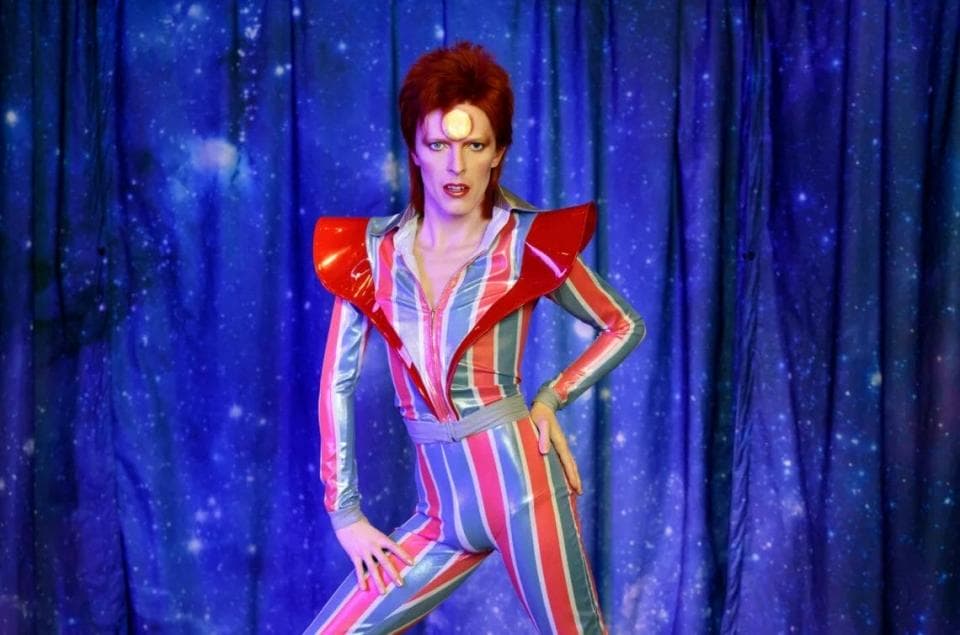David Bowie (1947 – 2016)
David Robert Jones, better known as David Bowie, was born on January 8, 1947, in Brixton, London. His half-brother Terry suffered from schizophrenia, spending many years in a mental hospital before tragically taking his own life in 1985.
David Bowie: Uno, Nessuno, Centomila
Terry played a crucial role in David Bowie’s upbringing, influencing his life and education. David’s first exposure to music came through Terry, who introduced him to writers like Kerouac, Ginsberg, and Camus, as well as jazz and American rock music. Their bond was strong, so when David learned of Terry’s suicide due to schizophrenia, he struggled to cope, fearing he might succumb to madness himself. In 1993, almost as a means to exorcise the growing negativity and mourn Terry’s death, he composed the song “Jump (They Say).”
In 1957, David Bowie’s family moved to the suburbs of Bromley, where he attended Bromley Technical High School and later became a commercial art designer after graduating. In 1959, he acquired his first saxophone, sparking a deeper interest in music. One day, on his way home from school, he got into a fight with his friend George Underwood, who punched him in the left eye, causing a serious injury and earning him the nickname “Left Eye” due to the blood vessels visible in his eye. However, he would later embrace this as a unique characteristic, as the injury left one eye permanently dilated and blue, while the other remained its natural hazel-green.
The 1960s saw the emergence of Swinging London, a vibrant rock music scene featuring iconic bands like The Beatles, The Rolling Stones, Pink Floyd, The Who, and The Animals. Young David Bowie was captivated, singing, playing saxophone, and attempting to make it with underground groups like the Manish Boys, The Konrads, King Bees, and Buzz. He dreamed of becoming the next Little Richard, his childhood idol.
The Birth of Singer David Bowie
Manager Kenneth Pitt suggested he adopt the surname Bowie to avoid confusion with Davy Jones of The Monkees, and thus began a solo career. David was always indecisive in style, torn between British folk, the psychedelic allure of California’s Summer of Love, and the blues revival. His debut album in 1967, “David Bowie,” presented an image of an immature, amateurish singer-songwriter to the audience.
Feeling like a misfit among his generation, Bowie sought refuge in Buddhism. He and partner Hermione Farthingale secluded themselves in a Scottish monastery with four Tibetan lamas for three months.
In 1969, as humanity first set foot on the moon, David Bowie released his single “Space Oddity.” This song marked the first space ballad in rock history and became a precursor to the science fiction genre, a style that would soon become his trademark.

In 1967, Bowie met mime artist Lindsay Kemp, becoming not only a singer but also an actor. From Kemp, Bowie learned the art of body language, precise control of gestures, and the dramatic impact of every movement, thus embarking on his journey onto the stage.
On March 20, 1970, Bowie married American Angela Barnett, a union that lasted for ten years and resulted in the birth of their son, Zowie.
David Bowie attended a concert by the London quartet Hype at the Roundhouse. His attention was drawn to the effeminate singer on stage with curly hair and colorful silk dresses. It was within this style that Bowie found himself: he abandoned his shy folk singer image of earlier years, embarking on the path of emotive and ambiguous rock.
In 1970, he released the album “The Man Who Sold The World,” featuring Bowie in women’s clothing on the cover. The lyrics were surreal, hovering between futurism and horror, Nietzsche’s Übermensch, and sexual deviance.
Bowie’s mature style was primarily based on an aesthetic of ambiguity and transformation. He was a proud “feminine” singer, unabashedly using his image, flamboyance, and desire for avant-garde artists to transform himself into the White Duke we know today.
David Bowie Glam Rock
Bowie openly embraced glam rock, a genre that exploded in Britain under the influence of Marc Bolan’s T. Rex, who later became Bowie’s close friend. “Hunky Dory” was a product of this musical subculture.
Escapism, cross-dressing, and sexual ambiguity flourished in a riot of sequins, feather boas, wigs, mascara, boots, and space suits. John Lennon referred to it as “lipstick rock.” Bowie had anticipated this trend on his previous album, realizing he had found his direction. On the cover of the new album, he struck a pose reminiscent of Greta Garbo’s fatal allure.
While rock celebrated itself at large peace rallies or in hippie communes, Bowie, in true Warholian fashion, was in the dressing room, looking in the mirror, searching for the right mask to confuse his audience. The answer would come from an incredible combination of extraterrestrial beings and Japanese Kabuki actors.
David Bowie: Between Superman and Alien
Perhaps no one would have bet on David Bowie, who presented to the public a man who was both feminine and masculine, wearing tight-fitting suits, carrot-colored hair, and makeup reminiscent of a low-grade drag queen. He was an unremarkable, grotesque figure, seemingly plucked from the pages of a trashy science fiction comic book. However, it was against this backdrop that Bowie first gained the long-sought, never-give-up world fame.
“The Rise And Fall Of Ziggy Stardust And The Spiders From Mars” is a concept album that tells the story of a “plastic rock star” and his rise to self-destruction. He is the “fallen angel,” the messiah of the rock revolution, but his rise and fall only last for a period.
In this allegory, Bowie’s art is fully presented: Warholian “15 minutes of fame,” Dorian Gray-esque decadence, imitation of the myth of stars and the ephemeral nature of consumer society, and, last but not least, Orwellian visions of a gloomy future. Ziggy Stardust is an “alien,” thus liberated from the sexual taboos that bind humans, he is the epitome of glamorous spirit. In him, the past and the future intertwine: he is a product of the decadent atmosphere of pre-war Central European cabarets, stretched into the futuristic momentum of Kubrick’s “A Clockwork Orange” (1971).


